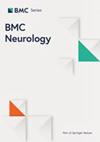Informing future randomized controlled trials of amantadine hydrochloride in neurocritical care and post-neurocritical care stroke patients through a retrospective study
IF 2.2
3区 医学
Q3 CLINICAL NEUROLOGY
引用次数: 0
Abstract
Amantadine hydrochloride has been increasingly prescribed as a neurostimulant for neurocritical care stroke patients to promote wakefulness during inpatient recovery. However, a lack of guidelines makes it difficult to decide who may benefit from this pharmacotherapy and when amantadine should be initiated during the hospital stay. This study aims to determine some factors that may be associated with favorable response to amantadine to inform future randomized controlled trials of amantadine in critical care or post-critical care stroke patients. Retrospective chart review for this study included neurocritical care and post-neurocritical care patients with acute ischemic or hemorrhagic stroke who were started on amantadine (N = 34) in the years 2016–2019. Patients were labeled as either responders or nonresponders of amantadine within 9 days of initiation using novel amantadine scoring criteria utilized and published in Neurocritical Care in the year 2021, which included spontaneous wakefulness and Glasgow Coma Scale (GCS). Amantadine response status and predictive variables were analyzed using nonparametric tests and adjusted multivariable regression models. There were large but nonsignificant variations in the median total milligrams of amantadine received in the first 9 days (IQR = 700-1,450 mg, p = 0.727). GCS on the day before amantadine initiation was significantly higher for responders (median = 12, IQR = 9–14) than nonresponders (median = 9, IQR = 8–10, p = 0.009). Favorable responder status was significantly associated with initiation in the critical care unit versus the step-down unit or the general medical/surgical floor [��=1.02, 95% CI (0.10, 1.93), p = 0.031], but there was no significant associations with hospital day number started [��=-0.003, 95% CI (-0.02, 0.02), p = 0.772]. Future randomized controlled trials of amantadine in hospitalized stroke patients should possibly consider examining dose-dependent relationships to establish stroke-specific dosing guidelines, minimum GCS threshold for which amantadine is efficacious, and the impact of patients’ determined level of acuity on clinical outcomes instead of solely examining the impact of earlier amantadine initiation by hospital day number. Future research with larger sample sizes is needed to further examine these relationships and inform future clinical trials.通过一项回顾性研究,为今后在神经重症监护和神经重症监护后脑卒中患者中开展盐酸金刚烷胺随机对照试验提供依据
越来越多的神经重症卒中患者在住院恢复期间使用盐酸金刚烷胺作为神经刺激剂来促进清醒。然而,由于缺乏相关指南,很难确定哪些患者可从这种药物治疗中获益,以及何时应在住院期间开始使用金刚烷胺。本研究旨在确定一些可能与金刚烷胺良好反应相关的因素,为今后在重症监护或重症监护后脑卒中患者中开展金刚烷胺随机对照试验提供参考。本研究的回顾性病历审查包括2016-2019年间开始服用金刚烷胺的急性缺血性或出血性卒中神经重症监护患者和神经重症监护后患者(N = 34)。在开始使用金刚烷胺的 9 天内,患者被标记为金刚烷胺应答者或无应答者,使用的是 2021 年在《神经重症监护》(Neurocritical Care)杂志上发表的新型金刚烷胺评分标准,其中包括自发清醒和格拉斯哥昏迷量表(GCS)。使用非参数检验和调整后的多变量回归模型对金刚烷胺反应状态和预测变量进行了分析。前9天接受的金刚烷胺总毫克数的中位数(IQR=700-1,450毫克,p=0.727)有很大差异,但无显著性。开始服用金刚烷胺前一天,应答者的 GCS(中位数 = 12,IQR = 9-14)明显高于无应答者(中位数 = 9,IQR = 8-10,p = 0.009)。有利的应答者状态与在重症监护病房或普通内科/外科楼层开始治疗有显著相关性[��=1.02,95% CI (0.10,1.93),p = 0.031],但与开始住院天数无显著相关性[��=-0.003,95% CI (-0.02,0.02),p = 0.772]。未来针对住院卒中患者的金刚烷胺随机对照试验应考虑研究剂量依赖关系,以制定卒中特异性剂量指南、金刚烷胺有效的最低 GCS 阈值以及患者确定的敏锐程度对临床预后的影响,而不是仅仅研究按住院天数提前使用金刚烷胺的影响。未来的研究需要更大的样本量来进一步研究这些关系,并为未来的临床试验提供参考。
本文章由计算机程序翻译,如有差异,请以英文原文为准。
求助全文
约1分钟内获得全文
求助全文
来源期刊

BMC Neurology
医学-临床神经学
CiteScore
4.20
自引率
0.00%
发文量
428
审稿时长
3-8 weeks
期刊介绍:
BMC Neurology is an open access, peer-reviewed journal that considers articles on all aspects of the prevention, diagnosis and management of neurological disorders, as well as related molecular genetics, pathophysiology, and epidemiology.
 求助内容:
求助内容: 应助结果提醒方式:
应助结果提醒方式:


